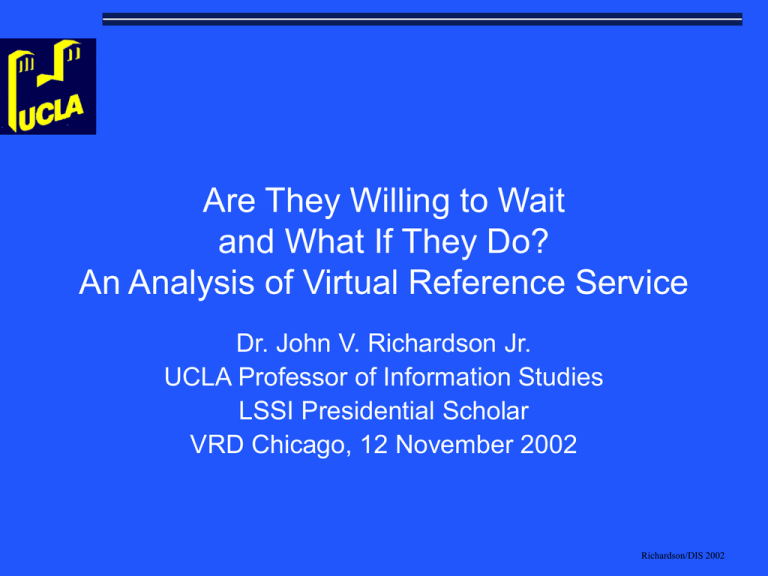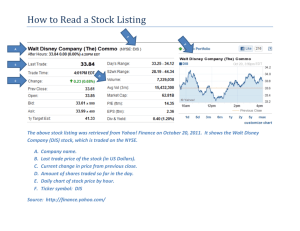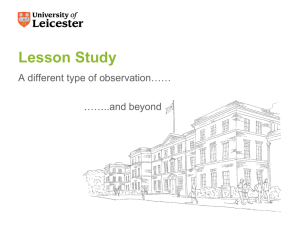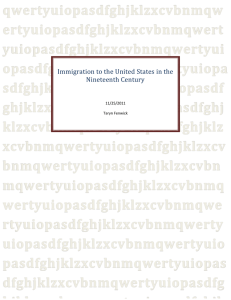Are They Willing to Wait... - UCLA Department of Information Studies
advertisement

Are They Willing to Wait and What If They Do? An Analysis of Virtual Reference Service Dr. John V. Richardson Jr. UCLA Professor of Information Studies LSSI Presidential Scholar VRD Chicago, 12 November 2002 Richardson/DIS 2002 Presentation Outline LSSI’s Virtual Reference Toolkit Wait Queues and Standards Service Duration and Standards Subsequent User Satisfaction Further Readings Richardson/DIS 2002 LSSI’s Virtual Reference Toolkit LSSI’s software version 2.5 captures time in queue, service duration, the entire virtual reference transaction (which can be email to the user at the end), and presents a user satisfaction survey at the end of every query. SOURCE: login at http://virtualreference.net or try the live demonstration while you are here at VRD and at http://www.vrtoolkit.net/Virtual_prod_serv.htmand Richardson/DIS 2002 Wait Queues Waiting time or time in queue can be measured as the number of seconds the user waits before the reference librarian joins the chat. Average values can be determined for all users, by types of library, or for a specific library Outliers equal more than 900 seconds (ie, 15 minutes) Negative values and missing values dropped from calculations Richardson/DIS 2002 Service Standard for Queues Call centers, including bank and telephone companies, have adopted varying service standards Ranging from thirty (N=30) seconds to as little as ten (N=10) seconds; the first standard requires less staff, the other more… Richardson/DIS 2002 More on Queuing Standards Most common standard is eighty (N=80) percent answered within twenty (N=20) seconds; stated as 80/20 or even easier standard of 80/30 seconds WHY? Because it is thought that decreasing wait times result in higher user satisfaction Standard deviation (SD) is a measure of how closely the data clusters around the mean…think of it as centrality or dispersion Richardson/DIS 2002 Time in Queue by Library All Types Lib 41.8 seconds SD 88.9 80/30: 76%; 80/20: 63% Academic Lib A 41.5 seconds SD 81.1 80/30: 72%; 80/20: 57% Consortia C SD 101 80/30:65%; 80/20: 52% 53.7 seconds What if the goal were 100% of all The goal is 30 seconds or even questions? the more demanding 20 seconds! Richardson/DIS 2002 Staffing Considerations Once one knows the queuing time, one can allocation staffing to the virtual reference center Using Erlang C or Pollaczek-Khintchine formulas Thereby helping to set user expectations because otherwise a certain percentage of users will not be satisfied… Richardson/DIS 2002 Dr. Jon Anton at Purdue University “Our entire database across all industries indicated that US call centers answer 80% of all calls in an average of 42 seconds.” SOURCE: http://www.benchmarkportal.com Richardson/DIS 2002 So, What?… It appears, based on nearly 20,000 real transactions that libraries, of any type, are not staffing virtual reference service adequately, even if one wishes to adopt a relative easier standard, e.g., the 80/30 rule… On the other hand, libraries are doing slightly better than the average of all industries, according to Purdue University’s database Richardson/DIS 2002 Service Duration Service duration can be defined as the amount of time, in seconds, spent in a chat with a user’s query. Average values can be determined for all users, by types of library, or for a specific library Outliers equal more than 3600 seconds (i.e., 1 hour) Negative values and missing values dropped from calculations Richardson/DIS 2002 Service Duration Standards Willingness to answer the query… Librarian satisfaction, not significant Client satisfaction, not significant Answering success, weak association SOURCE: Whitlatch (1990); only one study, though… Richardson/DIS 2002 More Duration Standards The research literature suggests average time spent on live, face-to-face reference transactions in public libraries ranges from twenty (N=20) to forty (N=40) minutes Academic library users may spend ten (N=10) to twenty (N=20) minutes with reference librarians SOURCE: Mary De Jong (1926); Herbert Goldhor (1967); Charles Bunge (1969; 1990); Whitlatch (1990); John Stalker (1996) Richardson/DIS 2002 Service Duration by Library All libraries 11.2 minutes SD 10.8 minutes Acad Lib A 8.9 minutes SD 9.1 minutes Acad Lib B 14.1 minutes SD 14.2 minutes Cons. C SD 11.1 minutes 12.3 minutes Richardson/DIS 2002 User Satisfaction Based on a thorough review of more than 1,000 citations (http://purl.org/net/reference), Matthew Schall (Vice President, Unifocus) and John Richardson have developed: PaSS ™, Patron Satisfaction Survey SOURCE: http://www.vrtoolkit.net/PaSS.html Richardson/DIS 2002 PaSS ™, Patron Satisfaction Survey 7-point Likert scale ranging from very … to average to very …: Comprehension of the question Friendliness (i.e., very friendly, average, very unfriendly) Helpfulness Promptness Self-reported satisfaction with the process SOURCE: http://www.vrtoolkit.net/PaSS.html Richardson/DIS 2002 Further Readings Matthew Saxton and John Richardson, Understanding Reference Transactions: Transforming an Art into A Science (New York: Academic Press, 2002) 1,000 citations at http://purl.org/net/reference Matthew Schall and John Richardson, "What LSSI has Done to Measure Satisfaction with the Virtual Reference Tool Kit," by Dr. Matthew Schall, Unifocus and John V. Richardson Jr., Presidential Scholar, LSSI; Germantown, MD: Library Systems and Services LLC, 17 April 2002. Richardson/DIS 2002





